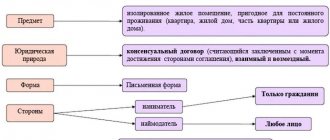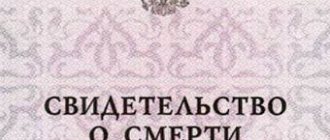About how to determine whether your apartment has been privatized, where to start the procedure for registering ownership, whether this can be done through a realtor or by proxy, and also about what to do if someone registered is against privatization and whether it is possible to achieve the right to registration through the court, you can learn from our articles.
What is an order and what does it look like?
An apartment warrant is a document that allows you to inspect the living space and move in. Before the collapse of the USSR, it was the main document giving the right to live in official housing.
Currently, a warrant is issued to a person who has received the right to reside in a municipal or service apartment for occupancy.
The order is an A4 document containing the following information:
- Full name, series and number of the resident’s passport;
- name of the authority that issued the warrant;
- address of the housing location;
- area provided;
- a surname list of the resident's family members;
- date of issue and expiration date.
The order consists of two parts - the main sheet and the tear-off spine, which remains with the authorized body that issued the document.
How can I get a copy if it is lost?
Despite losing its relevance, the housing order is valid today and is still an important legal document.
It is impossible to privatize an apartment without a warrant.
What to do if the order for the apartment was lost?
It is necessary to start restoring it as soon as possible. Restoring the original is a complex procedure that often takes a long time.
To restore it, you need to take several steps:
- apply for issuance to the repair and maintenance department; if the warrant is not stored there, then obtain a certificate of its absence from this organization;
- make the same request to the district administration; write an application for concluding a social rental agreement; draw up an agreement with the help of a housing specialist; if you receive a refusal, demand that the agreement be signed in court;
- contact the real estate department with a request for restoration;
- apply for restoration to the multifunctional center, which is obliged to satisfy your request.
Where to get it
A warrant is issued on the basis of a social rental agreement for municipal housing or an employment contract with an organization, as well as upon receipt of the right to a hostel for full-time university students.
Persons who have received the right to social rent are issued a warrant upon signing a tenancy agreement at the housing committee of the local municipality.
For those receiving official housing, employees, career military personnel and university students, warrants are issued before moving in or at the personnel department, commissariat or dean's office of the university, respectively.
Concluding a social tenancy agreement does not always imply immediate occupancy in an apartment. The issuance of warrants and the occupancy of persons who have signed a social tenancy agreement in practice occurs as free rooms or apartments become available.
Receiving an order is carried out without a queue for the following persons:
- disabled people;
- old age pensioners;
- large families;
- military personnel and employees when moving to a new settlement with their families.
To obtain a warrant, military personnel must submit the following documents, in accordance with paragraph 32 of Government Decree No. 1054:
- certificate of delivery of previous official housing;
- certificate confirming the absence of a privatized apartment in the host city;
- military ID;
- copies of passports of all family members (for children - copies of birth certificates).
The received warrant gives the right to move in within the period specified in the document.
The essence of the document
During the times of mass provision of free housing, move-in was carried out on the basis of a warrant .
It was a small document containing the data of those being moved in, the address of the facility, and the name of the issuing organization.
In those years, the distribution of housing , so it was their seal that was on the document.
This document lost its legal status with the adoption of the new Housing Code of the Russian Federation in 2005. Therefore, today there is no such name on the privatization lists. However, the presence of this paper is necessary for drawing up a rental agreement , which means that without it, registration in the property is not possible.
Find out on our website whether it is possible to privatize a cooperative or service apartment, military personnel’s housing, a share, a room in a communal apartment or dormitory, as well as an apartment with debts.
How to recover
If the warrant is lost, it must be restored in order to use the residential premises legally. To restore, you should contact the authorized service where the tear-off counterfoil of the order is stored, with the following documents:
- Russian passport;
- a copy of the social tenancy agreement;
- certificate from the house management.
Restoring the order takes 2-5 days, depending on the work of the authorized body that issued the residence permit.
If there are no other documents for the apartment besides the warrant, then the document is restored through the courts.
The absence of a social tenancy agreement is possible if you received an apartment in the period before 2001, when the only document for non-privatized housing in many municipalities was a warrant received from the enterprise. When going to court, you must present receipts for payment of utility bills and obtain testimony from neighboring witnesses confirming the plaintiff’s residence in the specified apartment.
Purpose and types
Initially, the warrant was issued to citizens who were moving to a new apartment. In fact, this is an analogue of today’s certificate of ownership, confirming the right to own the premises. It was a small paper that contained the following information:
- number;
- issued to (surname, initials);
- proof of the right to reside and move into the apartment;
- exact address and area of the premises;
- number of rooms in the apartment;
- signature of the head of housing and communal services.
Depending on the specific purpose, there are 4 types of orders:
- The official document was issued to a citizen who moved into an apartment not for permanent, but for a temporary place of residence (several months or years). Accommodation was associated with a long business trip, military service, work away from home, etc.
- A temporary one was usually issued for a period of up to 1 month or until a specific date. Its purpose is similar to that of an official document - this document was also issued to citizens in connection with work or study. However, a temporary order gave more rights to use the apartment than a service order.
- The inspection was issued for the future owner, who intends to inspect the premises in order to make a decision whether to move into it or not. The decision-making period was no more than 5 days.
- The exchange note was issued to those citizens who moved to another apartment. It was impossible to sell housing, so citizens of the USSR exchanged one premises for another, and thus changed their place of residence.
The first two types are currently completely out of document flow. They may remain in the hands of citizens (or in archives) to this day, but have no legal force. The second two are also not actually used. However, they serve as additional proof that the apartment belongs to a specific person during the privatization procedure. Therefore, exchange and review orders can be useful, and if they are lost, it is advisable to restore the document.
How to divide orders in a privatized apartment
The division of orders into several is often required in municipal apartments during divorce proceedings or if some residents wish to rent housing from the authorities under a separate agreement. This desire may arise due to:
- systematic violation by neighbors of the rules of living in the apartment;
- non-payment of utilities and other mandatory payments by neighbors;
- desires of neighbors to privatize housing according to separate documents.
Splitting the order allows you to separate the activities of your roommates and be responsible only for your own actions.
To divide a collective order into individual ones, you must:
- apply to the municipal housing committee with an application;
- wait for a decision to be made (up to 10 days);
- receive new orders.
When making a decision, municipal authorities evaluate the size of the isolated areas per family after the division of orders. The minimum area per person should not be less than 12 square meters. m.
Military personnel and enterprise employees living in official housing submit an application to the commandant of the military unit or the head of the personnel department, respectively.
The text of the statement states:
- required number of orders instead of one;
- the area per order after division;
- a list of residents assigned to each of the orders;
- the responsible employer of each order;
- grounds for separation.
If the apartment has already been privatized into common ownership, then its division into shares by order allows residents of each isolated area of the apartment to receive separate bills for electricity and other utilities.
After the privatization of the apartment, the orders cease to be valid, but the apartment is divided into shares proportional to the living space indicated in the order.
Step-by-step recovery instructions
The specific sequence of actions depends on which documents for the apartment are in the hands of the tenant. If there is a social rental agreement concluded with representatives of the local Administration, the order does not have to be restored, but the privatization procedure can immediately begin. If no documents have been preserved, you should act in this way.
Step 1. Visit to the Management Company
It is advisable to immediately contact the repair and maintenance department, since initially, during the existence of the USSR, it was in housing and communal services that citizens were given orders to move in. Therefore, if an employer directly contacts the Administration, it is highly likely that he will be sent first to the Management Company. You need to take with you:
- all documents related to obtaining an apartment (if any);
- passports of all residents of the territory (only those officially registered);
- birth certificates of all children who are also registered in this apartment (if they are over 14 years old, you must additionally take passports).
A free-form application is written on the spot (the form is issued by employees of the Management Company). It indicates a request to issue a coupon, which was torn from the warrant immediately after the citizen moved in. In most cases, this coupon will not be available, so the employer must be issued a certificate of absence of the document.
Step 2. Contacting the Municipal Administration
With this certificate, the employer goes to the local Administration. You need to take the same documents with you. A free-form application is written on the spot with a request to conclude a social tenancy agreement, if it has not yet been formalized.
If such an agreement has already been signed, but its original is lost, the situation becomes simpler. The applicant simply needs to ask in writing for a copy of the contract, after which he can begin the procedure for privatizing a state-owned apartment. However, if such an agreement did not previously exist, the applicant may ask to enter into an agreement with him.
Step 3. What to do in case of refusal
Since the Administration does not issue the order itself (it does not keep such a document), it may refuse to conclude a social tenancy agreement. In this case, you can independently go to the local archives or the real estate department to restore the document or at least confirm the fact of its existence in the past. The citizen will be given a copy of the order or a certificate stating that such a document was actually executed. With these papers, he returns to the Administration, asks to conclude a social rental agreement, after which he begins privatization.
If it is not possible to obtain a warrant (original, copy or certificate of its existence), there is only one way to resolve the situation - recognition of the right to reside in the premises through the court. The citizen will have to independently prove that even without supporting documents he has the right to living space. Witness testimony and any archival documents related to this apartment (for example, bills for housing and communal services) are involved.
Step 4. Implementation of privatization
The main purpose of restoring the document is not the order itself, but the opportunity to conclude a social rental agreement with the local Administration. After this, the tenant should take all the documents for the apartment and begin the privatization procedure. Contact the local BTI to measure the apartment and draw up an up-to-date technical passport.
Obtain the consent or refusal of everyone registered to participate in the privatization procedure (the document is certified by a notary). Then, with a complete set of documents, they go to the local Administration and follow its instructions. After this, the apartment is registered as the property, for which you will need to register at the local branch of Rosreestr. As a result, the owner is given a certificate from the Unified State Register of Real Estate, which has now completely replaced the certificate of ownership.
Obtaining an apartment by order
Checking into residential premises in the presence of a warrant occurs in the following order:
- presentation of the warrant to the manager of residential premises;
- payment for accommodation (if necessary);
- inspection and acceptance of the premises according to the acceptance certificate with an inventory;
- obtaining a document on the right of residence.
The warrant is presented to the commandant of a service or student dormitory, and in the case of municipal rentals, to the head of the housing management.
Payment for rental housing under an order can be differentiated according to the utilities actually consumed, when moving into municipal housing, or made in advance in the form of a single monthly payment - when moving into a service or student dormitory.
After submitting the warrant to the commandant, the occupant signs the acceptance certificate and 2 copies of the property inventory, keeping one for himself. The inventory contains a list of furniture and equipment in the residential premises being rented, as well as notes on the presence of cosmetic repairs (wallpaper, curtains, etc.).
When moving to another housing due to a move, a warrant for a new living space is not issued until the previous place of residence has been completely handed over according to the inventory. In case of loss or damage of part of the property, it is subject to compensation at the expense of the resident.
Form
Let's look at the two main forms that apply when moving into a home. An inspection warrant is issued before moving in. It is a one-page document with a tear-off coupon. The coupon remains in the executive committee. The document itself says that it was issued to a citizen (F.I.0) for inspection of an apartment located at such and such an address, its area, number of rooms, etc. are indicated.
It is valid for five days. After this, the person must either refuse in writing or accept the offered living space. If the citizen agrees, then the main order or the currently required documents, rental agreement, etc. are drawn up.
The occupancy order is also a one-page document with a tear-off coupon.
The order indicates the tenant, last name, first name, patronymic in full, the number of people moving in, their last name, first name, patronymic, year of birth, relationship with the tenant, information about the apartment, number of rooms, living space.
One part of it remains with the residents. The second is kept in the executive committee, now the mayor's office.
How to privatize an apartment without a warrant
Privatization of an apartment occurs on the basis of a decision of the local municipality, which is issued regardless of the presence of a warrant.
Only municipal housing space occupied under a social tenancy agreement can be privatized without a warrant.
Service housing and apartments for military personnel are privatized by order and in the presence of appropriate benefits for length of service.
To privatize an apartment without a warrant you should:
- prepare documents for the apartment;
- submit an application to the housing committee of the city administration;
- obtain permission for privatization;
- register ownership in Rosreestr.
To privatize an apartment, you will need a social tenancy agreement, a copy of your passport, as well as a purchase and sale agreement if the right to rent was acquired after 1992.
The application for privatization must indicate:
- name of the circulation authority;
- a list of all rights holders for the apartment by name;
- start date of residence;
- the type of law on the basis of which residential premises are occupied - municipal lease;
- address of the apartment location;
- cadastral number;
- living and common areas;
- number of rooms.
If the apartment has not yet been registered with the Unified State Register of Real Estate, then before privatization it is necessary to issue a technical passport.
In the absence of a warrant indicating the exact parameters of the living space, to obtain a technical passport, it is necessary to call specialists from the BTI to take measurements and draw up an explication plan.
After registration of the registration certificate, the apartment is registered with Rosreestr and assigned a permanent cadastral number.
Upon registration of the apartment and the availability of social tenancy rights, municipal authorities issue a permit for privatization. With this document, you must contact Rosreestr again, attaching a receipt for payment of the state duty (350 rubles), as well as the received registration certificate.
Watch the video for step-by-step instructions on how to privatize an apartment:
Is it valid now?
The role of an old-style certificate is performed by several types of contracts:
- commercial;
- social rental agreement;
- agreement on free use of real estate.
If you managed to obtain such a certificate before 2005, then upon concluding one of the above-mentioned agreements, this outdated document will finally lose its force.
Question answer
Is a warrant a document of title? – Yes, it is, but only in the absence of other title documents. In case of social hiring, such a document is an agreement with the municipality.
Where is the apartment warrant kept? – The order is kept by the representative of the house management in case of social renting or by the commandant of the hostel when living in official housing.
How many warrants can there be for an apartment? – The number of warrants issued for one living space depends on the number of living families and cannot exceed the number of rooms in the apartment. One person can only have one residential warrant.
An order is a document indicating the existence of the right to reside in official or municipal housing and determining the period of residence and the number of square meters occupied. If title documents are lost, they can be restored using a warrant.
Situations when a warrant is needed
Now, for the period of 2021, the legal nature of the order is completely lost. But sometimes it is still necessary.
Some legal transactions cannot be carried out without a warrant:
- In the case when a citizen enters into a social lease agreement. And this is impossible without presenting an old housing warrant. It is a kind of basis for issuing a new document.
- If a housing privatization operation is carried out. A new agreement is sometimes not concluded and not preserved by citizens. As a result, the order remains the only document confirming the residents’ right to living space.
But it should be taken into account that in the regions of the Russian Federation the procedure for privatization of housing is slightly modified: in some regions they may ask for an old order, and a copy must be made, but in others it will be possible to privatize only if there is a new social rent agreement.
Features of the procedure
Privatization by order has certain differences from the usual procedure and some nuances of the existing rights of residents. Citizens submitting an application may be refused on the following grounds:
- The document is lost , and no information about it has been preserved in any archive, and citizens are refused. Such actions by the authorities are unlawful, since the owner administration at one time was obliged to conclude a rental agreement with the residents. The absence of an agreement is a violation on the part of the authorities. You can complain about the actions of the administration to the Housing Inspectorate or the prosecutor's office, then go to court.
- The recipient of the warrant is a now deceased citizen , but authorities require a document issued to those currently registered. Such a requirement is also illegal. The basis for obtaining housing rights is the rental agreement, and they have no right to demand anything else.
- A special case is the attempts of former residents to obtain a share in a privatized apartment on the basis that they were previously included in the order. Moreover, even if someone is included in the document, but is not registered in it at the time of privatization, he does not have rights to the share. This citizen is also not included in the contract drawn up on the basis of the warrant.
The absence of a warrant is not an obstacle to privatization. You can become the owner of a living space both if you have a document and if it is lost . It is worth making a little effort to restore the information, and citizens will be able to become owners of their own square meters.
In what cases can privatization be refused?
There are legitimate reasons for the authorities’ refusal to enter into a privatization agreement:
- One of the applicants has already participated in the privatization of housing.
- The citizens indicated in the warrant are not currently registered in this apartment.
- The order and all data about it are lost. In this case, you will have to go to court, where proof of rights can be registration, as well as information about payment of utility costs.
- The administration requires a warrant indicating the previous deceased residents who initially moved into this apartment, for example, the parents of the current residents. This is not legal. It is necessary to submit a paper indicating currently living citizens and their registration, or a social tenancy agreement.
Restoration of documents for a cooperative apartment
If the documents have been lost, you will need to contact the Chairman of the Housing Committee. To do this, you need to draw up a statement indicating the circumstances that led to the loss of documentation.
After the applicant submits an application, the appeal will be considered at a general meeting. If the outcome is positive, preparation of an application for the issuance of new documentation will begin.
Important! The cooperative will approve the application only if the citizen has submitted certificates of payment of share contributions. If they were lost, then you need to contact the accountant of the housing cooperative.
Terms of consideration and price of the issue
The administration is given 30 working days to review the package of documents. After this time, a privatization agreement is concluded with the tenants of the premises within two months.
Registration of the contract requires payment of the following fees and state fees::
- technical passport, plan - from 1500 rubles;
- registration with Rosreestr – 500 rubles;
- extract from the Unified State Register – 500 rubles;
- refusal of share – 200 rubles;
- State duty for the Certificate – 2000 rubles.








